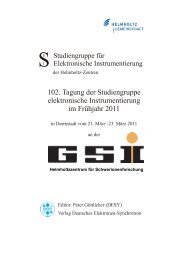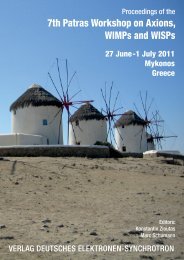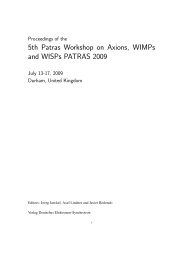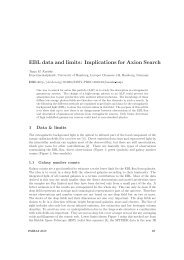Hamburg Neutrinos from Supernova Explosions ... - DESY Library
Hamburg Neutrinos from Supernova Explosions ... - DESY Library
Hamburg Neutrinos from Supernova Explosions ... - DESY Library
You also want an ePaper? Increase the reach of your titles
YUMPU automatically turns print PDFs into web optimized ePapers that Google loves.
CHRISTIAN OTT, EVAN P. O’CONNOR, BASUDEB DASGUPTA<br />
3.4 Effect of Collective Oscillations on Neutrino-driven <strong>Explosions</strong><br />
From the core-collapse supernova theory point of view, the most intriguing result of collective<br />
oscillations is the almost complete exchange of νe and νx and ¯νe and ¯νx spectra in the inverted<br />
mass hierarchy. The νx and ¯νx are emitted by thermal processes deep inside the core and<br />
their spectra are much harder than those of their electron-flavor counterparts. Due to the ɛ 2 νdependence<br />
of the charged-current absorption cross section, a swap of νx/¯νx and νe/¯νe spectra<br />
could dramatically enhance neutrino heating and may be the crucial ingredient missing in corecollapse<br />
supernova models, provided that the oscillations occur at sufficiently small radii to<br />
have an effect in the region behind the shock. To our knowledge, this point, in the context of<br />
collective oscillations, was first made by one of us [96].<br />
Suwa et al. [95] recently performed a set of 1D and 2D core-collapse supernova simulations<br />
in which they considered ad-hoc spectral swaps above 9 MeV for neutrinos and antineutrinos<br />
occurring at a fixed radius of 100 km, which is close to the gain radius (where heating begins<br />
to dominate over cooling) in their simulations. They considered a range of progenitor models<br />
and found that the heating enhancement by collective oscillations can indeed turn duds into<br />
explosions. This result was corroborated in a semi-analytic study by Pejcha et al. [97] in which<br />
the authors also considered different radii for the oscillations to become effective.<br />
Chakraborty et al. [87, 88] carried out the first multi-angle single-energy neutrino oscillations<br />
based on realistic neutrino radiation fields <strong>from</strong> 1D core-collapse supernova simulations.<br />
They discovered that the rather high matter density between protoneutron star and stalled<br />
shock strongly suppresses collective neutrino oscillations in the pre-explosion phase when multiangle<br />
effects are taken into account. Hence, the authors excluded any impact of collective<br />
oscillations on neutrino heating.<br />
In Dasgupta et al. [89], we carried out single-angle multi-energy and multi-angle singleenergy<br />
oscillation calculations based on neutrino radiation fields <strong>from</strong> 2D core-collapse supernova<br />
simulations performed with the VULCAN/2D code [26]. In 2D, convection and SASI lead<br />
to complicated flow patterns and large-scale shock excursions not present in 1D simulations.<br />
Even in our single-angle calculations and in the most optimistic case, we find that collective<br />
oscillations do not set in at radii sufficiently deep in the heating region to have a significant<br />
effect on neutrino heating. When including multi-angle effects, we also observe a suppression<br />
of collective oscillations, though not at the level argued for by [87, 88], who made different<br />
assumptions about the angular distribution of the neutrino radiation fields emitted <strong>from</strong> the<br />
neutrinosphere (ours are based on the angle-dependent neutrino transport results of [24]).<br />
As depicted by Fig. 2, we find that the heating enhancement due to collective oscillations, if<br />
present at all, stays below ∼0.1% at all times in both considered progenitor models when oscillation<br />
radii <strong>from</strong> full oscillation calculations are taken into account. This shows, in agreement<br />
with [87, 88], that the strong positive effect on the neutrino mechanism reported by Suwa et<br />
al. [95] is artificial and due primarily to their ad-hoc choice of a small oscillation radius.<br />
3.5 Collective Oscillations after the Onset of Explosion<br />
In Dasgupta et al. [89], we studied the suppression of collective oscillations by multi-angle<br />
effects at high matter density using multi-angle single-energy oscillation calculations for select<br />
simulation snapshots of the pre-explosion phase in 11.2-M⊙ and 15-M⊙ progenitors. We also,<br />
in a more heuristic approach, studied the potential for suppression of collective oscillations<br />
by comparing the MSW potential λ(r) with the expression λMA = 2 √ 2GF Φν,¯ν(R 2 νe /r2 )F−,<br />
Proceedings 30 of HAνSE 2011 HAνSE 2011<br />
9








